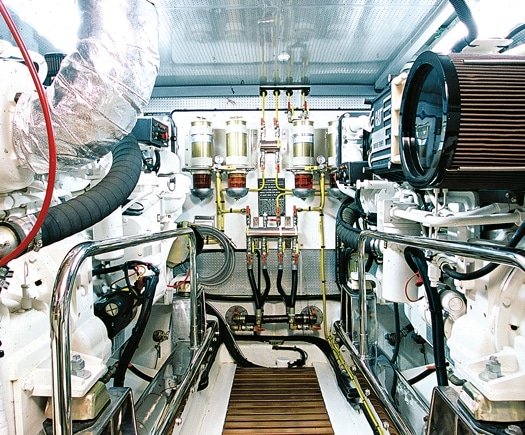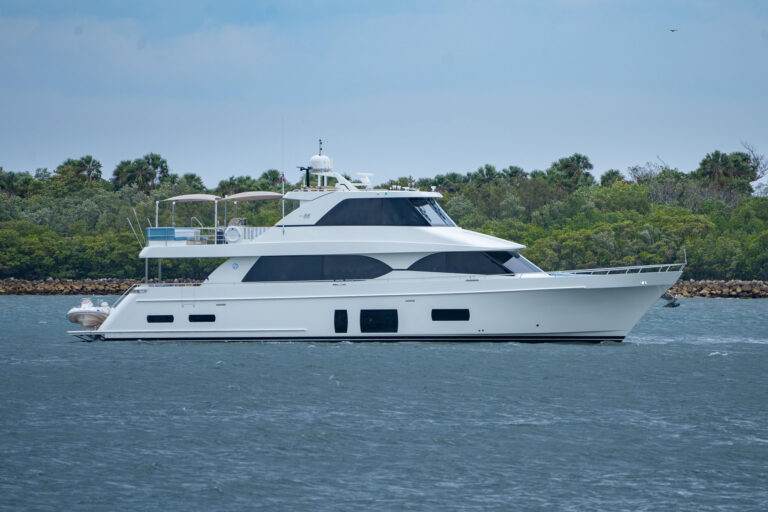
ytgfeb19yy525.jpg
Diesel engines don’t have sparkplugs. Instead, cylinders fire when a fine mist of fuel sprays into air superheated by a piston’s compression. Controlling precisely how and when that fuel sprays is the key to increased horsepower and fuel efficiency seen in recent engines. MAN’s 12-cylinder marine diesel, for example, once produced 1,200 horsepower. Electronic controls increased that to 1,300 horsepower in 1998. There it remained until common-rail injection bumped it to 1,360 in 2006. That same basic block produces up to 1,550 horsepower today (www.man-mec.com).
Even on an older diesel, that moment of fuel injection defines how well the engine runs, how much fuel it burns, and how clean the exhaust is. The flipside is that problems in the fuel system cause many dieselengine failures, including problems with components outside the fuel system. With so much riding on each tiny burst of atomized fuel, attention to a diesel’s fuel system will help keep it running like a Swiss watch.
Mechanically controlled diesel engines rely on a high-pressure fuel pump driven off gears in the engine. A barrel and plunger within the pump produces a measured shot of fuel for each cylinder, delivered at a precise moment based on how cam lobes are shaped and clearances set within the pump. Fuel then travels through a steel line to each injector, essentially a spring-loaded nozzle that opens under pressure and sprays fuel into a fine mist as the engine’s piston reaches the top of its stroke. A governor adds or subtracts fuel to maintain rpm based on feedback from the centrifugal force of a set of rotating weights. Simple adjustments are possible-for example limiting fuel until turbocharger air pressure can burn it-but once the pump and injectors are set, the time and shape of each pulse of fuel varies only with engine rpm. Some engines, like older Detroit Diesels, combine the pump and nozzle into “unit injectors” mounted directly atop each piston, but the principle is the same.
Electronic engines introduced in the mid 1980s replace mechanical governors with speed sensors and servos, and electronic injectors can adjust timing a bit, but computers are still only manipulating the basic parameters dictated by mechanical fuel pump technology that’s been around for half a century. “The injection event can only happen at a fairly specific point on the camshaft,” says Walt Kleban, an applications and service engineer at MTU (www.mtu-online.com). “You’re limited in when you can inject fuel.”
To overcome this limitation, common-rail fuel delivery removes the injector pump entirely. Overabundant fuel is delivered under pressure to all injectors simultaneously. “The high-pressure pump is just a pump. All it does is produce injection pressure constantly,” Kleban says. “That’s where the [common] rail comes in, a large-diameter fuel line from the pump to all the injectors. The injectors are controlled electronically. Each injector acts like a valve to regulate fuel to the cylinders.” By eliminating the camshaft-dependent injection pump, common-rail injectors have limitless control over the time, shape, and duration of each spray of fuel. Three or more individual pulses of fuel injected during each firing stroke of the piston pre-ignite the fuel, power the piston, and clean up fuel remnants within the cylinder.
Here’s the tricky part: Injectors must react to electronic commands in nanoseconds, with injection events measured in microseconds-far faster than simple electronic valves can accomplish with large volumes of fuel. The solution is very high fuel pressure powering hydraulic valves within injectors. Electronic solenoids trip the hydraulics. “We’re not moving big volumes of fuel with electronics, just relieving pressure [to open a valve], so the timing is very quick,” Kleban says.
But tremendously high fuel pressure operating complex valves with incredibly tight tolerances means clean fuel is more important than ever. Older fuel systems allow particles up to seven or eight microns to pass through filters and fuel systems harmlessly. Today’s engines typically filter to two microns. “The new systems are extremely sensitive to particles and moisture,” says Mike Kirkman, technical communicator at Gregory Poole Marine Power in North Carolina (www.gregorypoole.com). Kirkman also trains Caterpillar technicians. “The tolerances are getting tighter and tighter, so the maintenance is critical,” he says.
Fuel systems may be more sensitive, but new engines are actually becoming more reliable. Common-rail injections smooth out jarring diesel explosions inside cylinders, and individual components are more durable. For example, in older engines moisture in fuel often blows tips off injectors. Those tips find their way through exhaust systems, damaging valves or turbochargers. Unatomized fuel from a blown tip can burn too late, overheating and melting aluminum pistons or damaging exhaust components. Excess fuel can also wash away lubricating oil, rapidly wearing piston rings and liners, and even find its way into engine oil, diluting its ability to protect all engine parts.
“The newer injectors, common rail or not, don’t have problems of blowing tips off like we used to,” says Kirkman. “[Water] may split a tip, but erosion is mostly what we see now.” Wearing spray holes in injectors is normal and predictable, even being calculated into the newest engine fuel computers based on the age of each individual injector, but contaminated fuel speeds this process. “Because of the high [fuel] pressures we’re running now, high sulfur content in fuel in South America, Central America and Mexico, and moisture in the fuel, any contaminants are going to erode those tips quicker, and they won’t atomize fuel as well.”
Boats traveling in areas with high sulfur in fuel may require more maintenance, but fuel contamination is a far bigger concern. As filters clog, higher vacuum can draw water through filter elements that normally shed it. “Even air will cause problems,” Kirkman says. “Once you exceed nine inches of vacuum, you actually start to pull air bubbles out of the fuel itself.” Kirkman notes that, over time, air can damage pump barrels and plungers and erode injector seats and valves. He recommends monitoring fuel restriction downstream of Racor filters and never exceeding eight inches of mercury vacuum. “That [fuel] filter is a whole lot easier to change than high-dollar fuel system and engine components,” Kirkman says. By eliminating the complex injection pump, common-rail fuel systems are less expensive overall, but injectors can exceed $1,000 each.
While sulfur in fuel damages fuel systems, removing it from the fuel is problematic as well. “Some crude naturally doesn’t have much sulfur, but the vast majority does,” says Jack Devanny, a technician at Diesel Injection Service in West Palm Beach, Florida (www.dieselinjectionservice.com). “When they remove the sulfur they also reduce the fuel’s lubricity.” Newer engines are better protected from less-lubricating fuel- for example hardened inserts in cylinder head exhaust valve seats prevent wear- but engines built in the ’90s and before may benefit from fuel additives that replace lost lubricity. Check with your mechanic, since the newest engines often recommend against fuel additives.
Clogged fuel filters are also responsible for many repairs in Devanny’s shop. “Traditional pumps and injectors draw a high volume of fuel. Most of that gets dumped back into the tank, but that return fuel is essential to cool and lubricate the pump,” Devanny says. “You have to take care of your engine oil, too. [Often] injectors are under the valve cover and bathed by engine oil. Many parts rely on that motor oil.”
Today’s fuel-system electronics often warn of deficiencies before damage occurs, but sophisticated sensors can cause problems themselves, and computers can also compensate for trouble, masking symptoms. “These engines are much more reliable than older products, but they give you more subtle insights into a problem. If you’re starting to notice an increase in smoke when accelerating or at cruise, you’ve exceeded the limit of what the fuel system can compensate for,” Kirkman says. “Don’t automatically think worst-case scenario. It could be a $50 sensor, but it could also be the making of something bad.”
Swiss watches were marvels of engineering, but the simple quartz crystal proved better for simple, accurate timekeeping. Common rail similarly streamlines fuel delivery and timing, promising even more horsepower, better efficiency, and cleaner engines as time marches forward.









